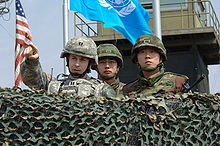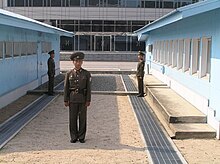So, the war between North Korea against South Korea, the U.S. and Japan continues today unabated. So, so many people have been starved to death in the name of this war continuing until today in many ways it is much worse than what Hitler did to the Jewish people during World War II because this torture and death of the North Korean people ongoing has continued ongoing to this day since 1950 and before. In fact, Kim Jong Un is telling his people to not eat or have electricity because the war has intensified. This gives him stronger martial law during this period where North Koreans can be harmed more right now than ever before since 1954.
begin quotes from:
Armistice (July 1953 – November 1954)
Men from the Royal Australian Regiment, June 1953.
In 1952, the United States elected a new president, and on 29 November 1952, the president-elect, Dwight D. Eisenhower, went to Korea to learn what might end the Korean War.[258] With the United Nations' acceptance of India's proposed Korean War armistice,[259] the KPA, the PVA, and the UN Command ceased fire with the battle line approximately at the 38th parallel. Upon agreeing to the armistice, the belligerents established the Korean Demilitarized Zone (DMZ), which has since been patrolled by the KPA and ROKA, United States, and Joint UN Commands.
The Demilitarized Zone runs northeast of the 38th parallel; to the south, it travels west. The old Korean capital city of Kaesong, site of the armistice negotiations, originally was in pre-war South Korea, but now is part of North Korea. The United Nations Command, supported by the United States, the North Korean People's Army, and the Chinese People's Volunteers, signed the Armistice Agreement on 27 July 1953 to end the fighting. The Armistice also called upon the governments of South Korea, North Korea, China and the United States to participate in continued peace talks. The war is considered to have ended at this point, even though there was no peace treaty.[36] North Korea nevertheless claims that it won the Korean War.[260][261]
After the war, Operation Glory was conducted from July to November 1954, to allow combatant countries to exchange their dead. The remains of 4,167 U.S. Army and U.S. Marine Corps dead were exchanged for 13,528 KPA and PVA dead, and 546 civilians dead in UN prisoner-of-war camps were delivered to the South Korean government.[262] After Operation Glory, 416 Korean War unknown soldiers were buried in the National Memorial Cemetery of the Pacific (The Punchbowl), on the island of Oahu, Hawaii. Defense Prisoner of War/Missing Personnel Office (DPMO) records indicate that the PRC and the DPRK transmitted 1,394 names, of which 858 were correct. From 4,167 containers of returned remains, forensic examination identified 4,219 individuals. Of these, 2,944 were identified as American, and all but 416 were identified by name.[263] From 1996 to 2006, the DPRK recovered 220 remains near the Sino-Korean border.[264]
Division of Korea (1954–present)
See also: Division of Korea and Korean Demilitarized Zone
Delegates sign the Korean Armistice Agreement in P'anmunjŏm
In April 1975, South Vietnam's capital was captured by the North Vietnamese army. Encouraged by the success of Communist revolution in Indochina, Kim Il-sung saw it as an opportunity to invade the South. Kim visited China in April of that year, and met with Mao Zedong and Zhou Enlai to ask for military aid. Despite Pyongyang's expectations, however, Beijing refused to help North Korea for another war in Korea.[267]
A U.S. Army officer confers with South Korean soldiers at Observation Post (OP) Ouellette, viewing northward, in April 2008.
The DMZ as seen from the north, 2005.
After a new wave of UN sanctions, on 11 March 2013, North Korea claimed that it invalidated the 1953 armistice.[270] On 13 March 2013, North Korea confirmed it ended the 1953 Armistice and declared North Korea "is not restrained by the North-South declaration on non-aggression".[271] On 30 March 2013, North Korea stated that it entered a "state of war" with South Korea and declared that "The long-standing situation of the Korean peninsula being neither at peace nor at war is finally over".[38] Speaking on 4 April 2013, the U.S. Secretary of Defense, Chuck Hagel, informed the press that Pyongyang "formally informed" the Pentagon that it "ratified" the potential use of a nuclear weapon against South Korea, Japan and the United States of America, including Guam and Hawaii.[272] Hagel also stated the United States would deploy the Terminal High Altitude Area Defense anti-ballistic missile system to Guam, because of a credible and realistic nuclear threat from North Korea.[273]
In 2016, it was revealed that North Korea approached the United States about conducting formal peace talks to formally end the war. While the White House agreed to secret peace talks, the plan was rejected due to the country's refusal to discuss nuclear disarmament as part of the terms of the treaty. Any possibility of talks ended on 6 January when they conducted their fourth nuclear test.[274]




No comments:
Post a Comment